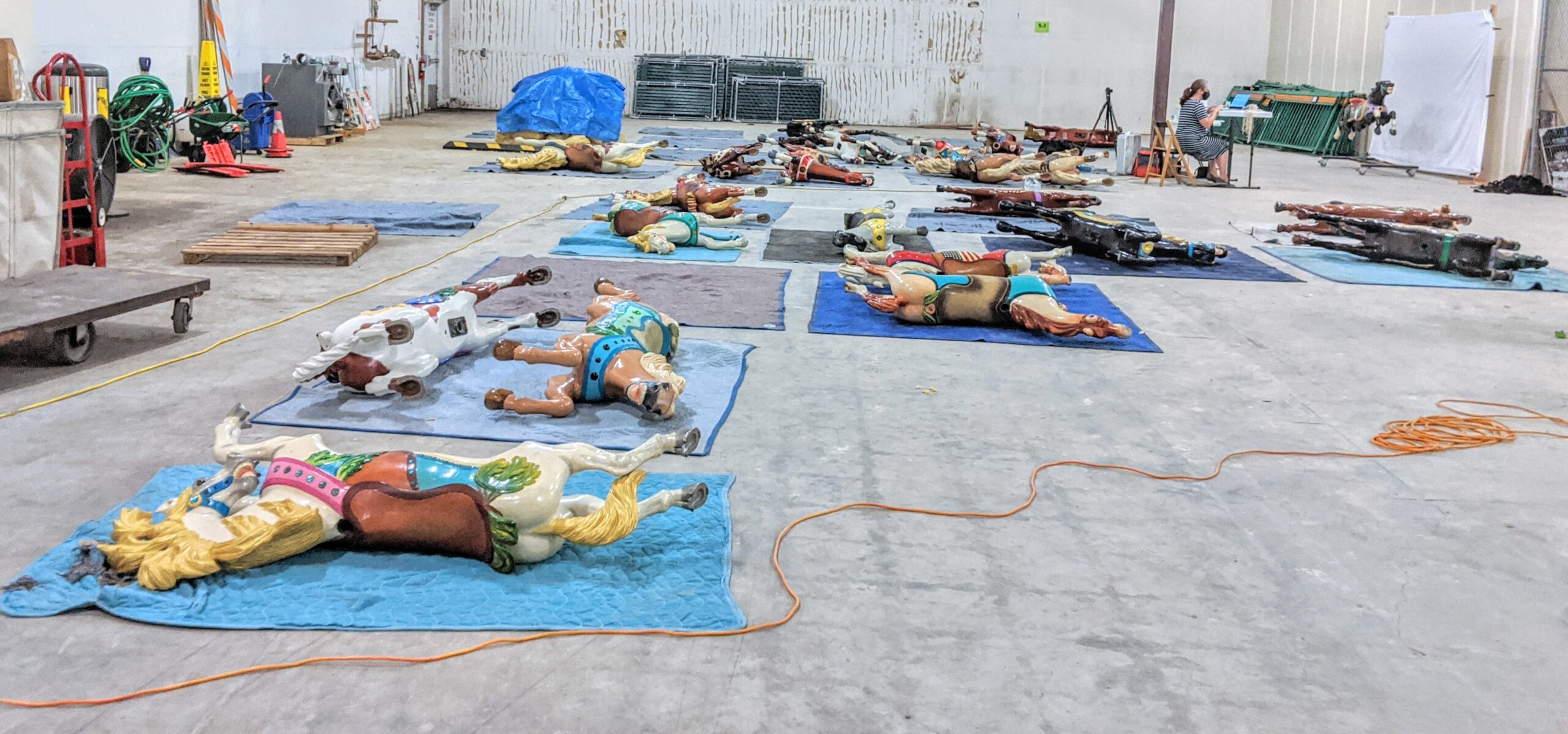
Back in 2017, when the Jantzen Beach Carousel was offered to our organization, we had to scramble to make acceptance of such an unusual donation possible. Simply scraping together funds to pay for storage and insurance was a challenge. So, while we would have loved to have launched our stewardship with a thorough inventory and condition assessment, moving, examining and documenting 82 carousel horses (many of which weigh over 400 pounds) was simply too big of a lift, financially and literally! Instead, we temporarily relied upon a decades-old inventory provided by the carousel’s previous owners, while working to raise funds necessary to fully explore this historic resource and understand its unique needs.
With funding finally in place, Restore Oregon staff and volunteers spent four long, hot days in August 2020 conducting a full inventory and assessment of our herd. This was a foundational step in solidifying the Preservation Roadmap we are crafting to guide full restoration of the carousel, and it involved far more than just counting horses. Our goal was to create a detailed digital record of the herd’s condition and useful tools for guiding future preservation work.
We began by gently cleaning all of the horses, most of whom had not had a proper bath since being placed in storage in 2012. This involved gently removing years worth of dust and grime, countless soda pop drips, and a variety of sticky substances, including wads of hardened gum firmly lodged in horses’ ears and noses!
Descriptions of each horse, including length, height, posture, distinctive carvings, number of jewels, and types of manes, tails and horseshoes, were entered into a database using the same numbering system used in a vintage inventory document from 1993. This allowed us to cross-check current day information against older documentation effortlessly. Horses were then examined for broken limbs and tails, gouges and cracks, and damaged jewels and carvings. A neodymium magnet was used to locate nails and metal patches. Detailed descriptions of every horse’s problem areas were added to the database.
Next, we photographed the romance and inner-facing sides of each horse. Twice.
With the first set of portraits, we used a color-coded tape system. Green tape indicated cracks and other types of wood damage, while blue tape identified the presence of metal, which typically indicates adjacent dry rot. For the second set of photos, we shot high-resolution digital portraits which have since been used to create line drawings of each horse.
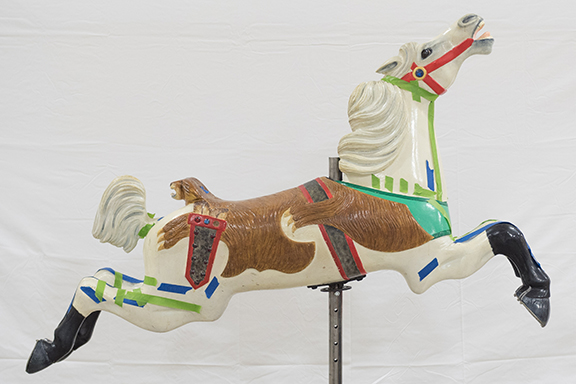
Above Photo: What is true for historic buildings is also true for carousel horses. Documenting damage is a critical first step in understanding the scope of a preservation project. Green tape indicates cracks and other wood damage, while blue tape indicates the presence of metal – usually patches or rusty nails.
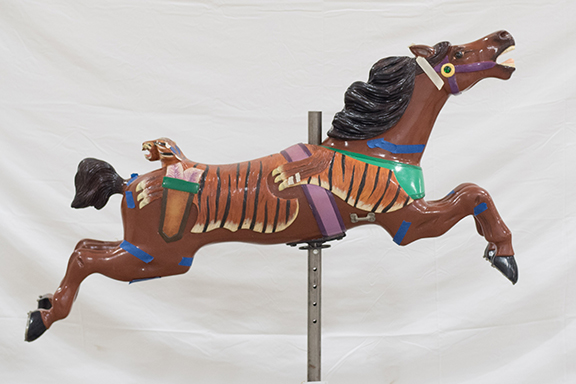
Above Photo: Our tiger-pelted horse one was one of the least damaged horses in our herd. It had very few visible cracks but numerous metal patches. Because of its relatively good condition, we chose to repair this horse along with two others to try to understand the full spectrum of the herd’s repair needs.
By the end of the assessment process, we had amassed detailed written and photographic documentation of each horse’s condition, which provided a clear path forward in selecting horses on which to test repair methods. Using data collected during the assessment, we selected three horses to repair. Each was chosen for its unique injuries, with the goal of learning how to deal with any type of damage we were likely to encounter in the future, including broken limbs and tails, glue-joint separations, damaged carvings, and rot. This phase of repair testing was critical as it exposed damage beneath the paint layer invisible during the assessment. It also allowed us to confirm which repair methods worked best, and to document how long each repair took to make, both of which were key steps in refining the Preservation Roadmap.
The photography portion of the assessment process was also critical in developing the Preservation Roadmap. Not only did our horse portraits provide us with a visual record of each horse’s damage, they also helped us to refine our paint protocol. Prior to doing this work, we’d tested primers, paints and topcoats on sample pieces of wood to determine which products would perform best, but we understood the true test would come when painting an actual horse.
Portraits without tape were used to create line drawings of each horse. Altering digital photos of our horses in this way provided us with base drawings for renderings for each horse, ensuring that the renderings would be to scale, and the carvings would be accurately represented.
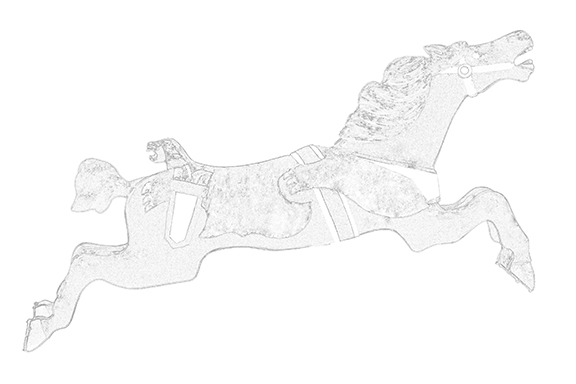
Above Photo: A line drawing of the tiger-pelted horse created from the digital portrait taken during the inventory process.
Most of our horses lost their original paint layer decades ago, which means we no longer have a physical record of their original paint colors. Instead, we often need to make informed guesses when deciding how to repaint. However, in the case of our tiger-pelted horse, we were fortunate enough to discover a photo of the horse on our carousel, at the Parker factory in Kansas, before it shipped to the West Coast in 1921.
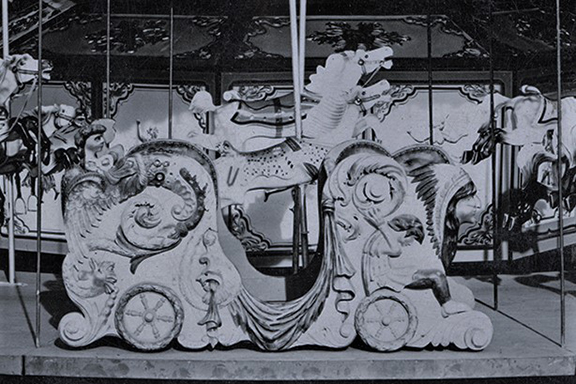
Above Photo: This historic photo shows our tiger-pelted horse (center, directly behind the chariot) with his original paint job. Photo courtesy of C.W. Parker Museum, Barbara Fahs Charles Archives.
This wonderful historic photo has guided us in recreating our tiger-pelted horse’s original spotted pelt, and its ivory coat and mane. (We did have to make educated guesses about the horse’s collar, as it is not visible in the photo.) Using line drawings created from the tiger-pelted horse’s portrait as a base, we were able to create multiple renderings in different colorways. Because we were working from a black and white image, we narrowed our color choices by viewing photos of horses from the same era with original paint colors intact, by referencing paint catalogs from the 1920s, and by consulting reference books. As soon as we agreed upon a winning color approach, the painting process began.
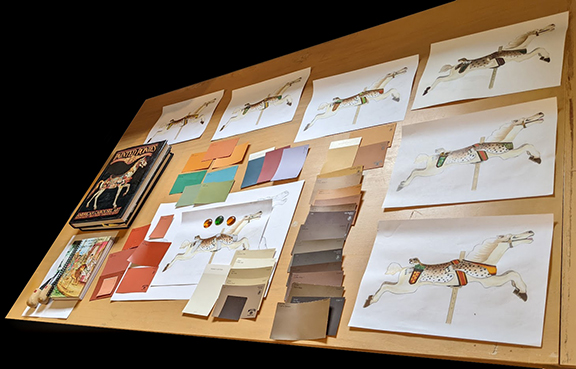
Above Photo: Guided by research, reference books, and whenever possible, historic photos, we create renderings in multiple colorways and before selecting a final color approach.
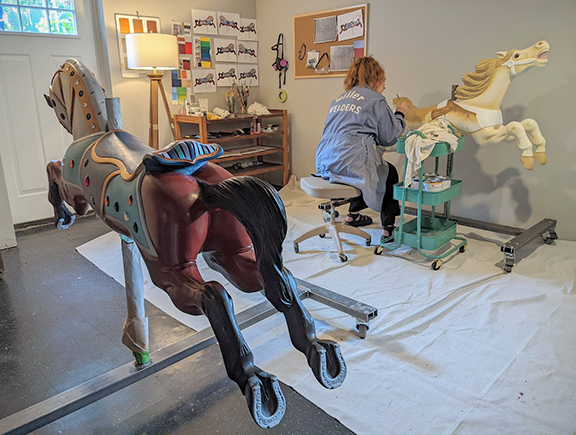
Above Photo: Artist Cora Finney uses drawings created from portraits shot during our inventory and condition assessment process to create the renderings that guide repainting of our herd.
Once painted and clear-coated, our ivory bobcat-pelted horse will be loaned, along with three other horses, to the Oregon Historical Society to be displayed as part of their upcoming exhibit, The Odyssey of the Historic Jantzen Beach Carousel - From Leavenworth, Kansas to Portland, Oregon, 1921 - 2022. Scheduled to open November 18, 2022, the exhibit will stretch across three galleries, and tell the fascinating story of the Jantzen Beach Carousel from its construction in 1921 through present day. Photographs and video of our inventory, assessment, repair, rendering, and repainting processes will all be on display alongside historic carousel photographs and artifacts, providing visitors a long-awaited opportunity to reconnect with the carousel. Our staff, and freshly repaired and painted horses, hope to see you there!

